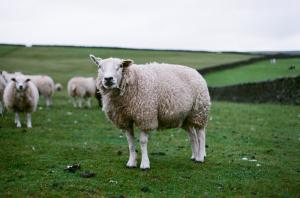
By vet Chris Bailey
Autumn brings sheep sales, making it an ideal time to review quarantine treatments and protocols. Each farm is different, so it's essential to adapt your approach to your specific needs. Here are general guidelines, but it is advisable to also consult a vet, so you get personalised advice.

Wormer Resistance
Wormer resistance in the UK was first noted in 1984 for white wormers, in 1996 for yellow wormers, and in 2007 for clear wormers. Since then, resistant worms have steadily increased. A 2017 study in southwest England showed that 90% of farms had white wormer resistance, and 60% had resistance to yellow or clear wormers. Multiple-resistant worms—those resistant to more than one class of wormers—are also becoming more common.
Resistance can develop naturally over time, but bringing in sheep already carrying resistant worms is the fastest way to introduce the issue. If your farm already has wormer resistance, importing resistance to another class could significantly limit your treatment options.
Worm Treatment for New Sheep
All incoming sheep should be treated with Zolvix, a new orange class wormer with very low resistance. Since sheep may still shed worm eggs for a few days after treatment, it's best to house them or graze them on land that won't be used by sheep again, such as fields going into cropping or being grazed by cattle. After treatment, graze them on "dirty" pasture, where lambs have previously grazed, so that any surviving worms are diluted by your farm's worm population.
Sheep Scab and Liver Fluke
Sheep scab is increasingly problematic, and treatments often have long meat withdrawal times. Additionally, resistance to injectable wormers used for scab is rising, so these products should be avoided. Dipping is the preferred treatment for scab in new sheep. If dipping facilities aren’t available, try to coordinate your purchases with a full flock dip by a mobile dipper. Injectable treatments can be used if necessary, but scab mites can survive for up to 16 days off-host, so avoid using the same handling facilities for quarantined and home flock sheep.
For liver fluke, buying sheep from unknown sources can introduce the parasite, particularly if fluke-resistant to triclabendazole is present. Closantel-based products can kill adult fluke resistant to triclabendazole but not immature ones, so a second treatment six weeks later is required. Keep treated sheep on low-risk pasture, as they can pass fluke eggs for up to three weeks.
Foot Rot and Other Diseases
Foot rot is common, but different farms may have varying strains, with some being more severe. Introducing new strains could cause a flare-up. Contagious ovine digital dermatitis (CODD) is another infectious lameness that can create serious problems when introduced to a naive flock. To reduce risks, isolate new sheep for two weeks and footbath them three times during that period. Use a 3-5% formalin solution, and treat any lame sheep with injectable antibiotics, keeping them isolated longer if necessary.
Final Considerations
Other infectious diseases can be introduced through new sheep, so isolating them for three weeks is crucial to monitor for issues. Some diseases, like orf and enzootic abortion, can be vaccinated against, and accreditation schemes exist for disease-free flocks such as maedi visna. However, some diseases, like OPA or Border disease, are harder to detect, so there is always some risk when buying stock.
In summary, taking the time to implement careful quarantine measures, treat new sheep, and monitor for resistance and disease can help maintain a healthy flock and prevent unwanted surprises.